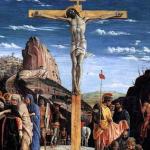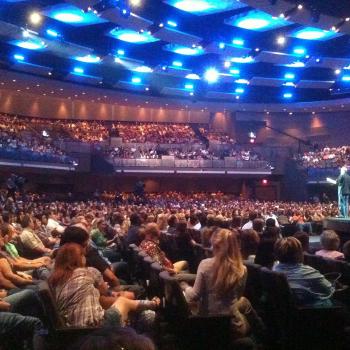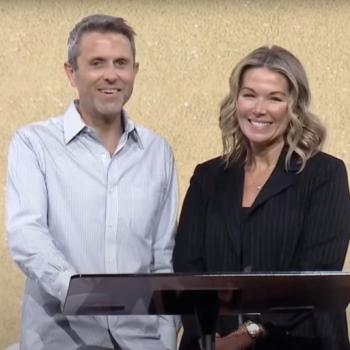Leviticus is divided into thirty-seven speeches, each introduced by “Yahweh spoke to Moses” (see Warning, Literary Artistry in Leviticus). The 19th speech – the central one – is Leviticus 16, instruction for the “day of coverings.”
From this, one can derive a simple chiastic outline of the book (I’ve discussed this in more detail in my essay in The Glory of Kings):
A. Offerings, chapters 1-7
B. Priestly ordination; fall and fire-punishment, chs. 8-10
C. Laws of uncleanness: defile sanctuary, chs 11-15
D. Day of coverings, ch 16
C’. Laws of society: defile land, chs 17-20
B’. Priestly regulations; fall and stone-punishment, chs. 21-24
A’. Jubilee and things consecrated, chs. 25-27
The links are fairly self-evident, but it’s important to note that the matching sections don’t merely match; there is a progression from the first to the second half of the book. Priestly ordination (B) places the ordained under the stricter regulations outlined in B’. There is a link between the things that flow from the flesh and defile the person and the sanctuary on the one hand (C), and violations of one-flesh relation that pollute the land on the other (C’).
That suggests that the may sequence is from sanctuary to land. Chapters 17-20 are the turning point. The first seven chapters are about offerings, and the ordination narrative is about the sanctuary officers, the priests who care for the sanctuary.
The sanctuary is still an issue in the cleanliness laws in chapters 11-15, but those chapters begin to shift attention to land. The first reference to the land occurs in 14:34. After the beginning of chapters 18, the land becomes the dominant concern. The word ‘eretz appears 19x in chapters 18-20, and references to land frame the whole of chapters 18-20 (18:3; 20:24).
The shift from sanctuary to land isn’t absolute. 20:3 refers to defilements of the sanctuary. But there is a general shift of focus. Israel’s life is divided between life in the sanctuary and life in the land, between garden and land.
As Jim Jordan has pointed out in a number of places, Leviticus builds on the early chapters of Genesis. It assumes the latter chapters of Exodus, which describe the formation of the garden and the creation of man (Exodus 25-40). The early chapters of Leviticus give us the system of offerings, which are the protocols for approaching Yahweh in His house. Leviticus 8-9 are about the formation of a priesthood, the new Adams, Aaron and the helpers suitable to him, his sons.
As soon as the tabernacle is finished, there is a fall scene. Nadab and Abihu bring foreign fire into the tabernacle, and the Lord’s fire breaks out against them (Leviticus 10). The sanctuary is defiled, the garden is ruined, and the whole system has to be redone.
The following chapters describes regulations regarding uncleanness, which are various forms of death and curse. All are linked to the curses of Genesis 3. Unclean animals are animals that, like Satan, crawl in the contaminated dust (Leviticus 11). A woman who bears a child is unclean because childbearing has been cursed (Leviticus 12). Jordan connects skin disease to the sweat that appears on Adam’s brow as he works to overcome the thorns and thistles that come from the earth (Leviticus 12-14). Uncleanness from the “flesh” is uncleanness from the sexual organs, which have been cursed (Leviticus 15).
Chapter 16 completes this cycle. Adam and Eve were naked and unashamed, but once they sin they realize they are naked and experience the shame of that state. They make coverings from fig leaves, but that proves to be an unsuitable covering. They need garments that the Lord alone can provide, and He does provide them in Genesis 3, clothing them in garments of skin. That is the first day of covering. Leviticus gives an elaborated ritual of covering in the day of atonements.
This scheme works, but the concerns of Genesis 1-3 persist into the latter chapters of Leviticus. Leviticus 18 and 20 are also operating in the realm of Genesis 1-3. The rules of incest in Leviticus are rooted in Genesis 2’s requirement that a man leave his father and mother and cleave to his wife. He leaves behind one household, one set of “flesh of flesh” relations for a new fleshly relation with his bride. Further, Genesis 18 and 20 describe sexual sin as “uncovering nakedness,” which reaches back to Genesis 3’s concern with nakedness, covering, and uncovering.
When we link the chiastic structure to the pattern from Genesis 1-3, we can speculate that the latter chapters of Leviticus work from Genesis, but in reverse order, Genesis 3-1. In Leviticus 1-16, we move from garden to man to fall to covering. Then we move back to fall/nakedness in chapters 17-20, man’s creation in the priestly passages leading up to chapter 24, and a re-formation of the garden and land in the final chapters.
In short, Leviticus tells the overall biblical story of creation-fall-redemption. It moves from God’s formation of a new world centered on the tabernacle, through the ruination and pollution of that world, to Yahweh’s solution to the damage of creation – the day of coverings.
Having covered Israel’s sins and impurities, Leviticus lays out the pattern of life for Israel in the land, assures Israel that Adamic priests will care for the sanctuary, and encourages Israel to hope for a coming day of Jubilee, when the land will be restored and devoted to God.















